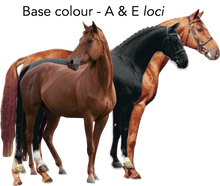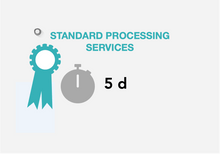Buy a Base colour test and find out if your horse's base colour is Black, Bay or Chestnut.
Results within 24 h are available.
-
DNA test for the Agouti and Extension loci that controls distribution of Black and Red pigment throughout the coat.
Sample
- 30 to 40 hair roots
- 5 mL - blood - K3 EDTA tube
Turnaround time
Standard processing - Results in 3-5 working days after sample arrival at the laboratory. Clients organize and support the costs of sending the samples to the laboratory.
PREMIUM processing - Results in 1 day after sample arrival. Includes free express delivery** . The laboratory organizes Express shipping with pick-up of the package at the client's address and delivery at the laboratory.
-
** PREMIUM SERVICES INCLUDE AN EXPRESS SHIPPING DELIVERY FOR EUROPEAN COUNTRIES FROM NON-REMOTE REGIONS.
Check here to know if you are in a remote European region.
For remote/outreach regions EXTRA fees are applied.

Why test?
Horses have only three base colours: Bay, Black or Chestnut
These different colours are controlled by 2 loci, the Extension (Red/Black) and Agouti.
The Extension locus controls the production of black or red pigment throughout the coat. The allele for black color (E) is dominant over the red allele (e), so a horse only needs one copy of the black allele to appear black-based. But if the horse has two alleles (e/e) he will appear Chestnut.
The Agouti locus can then modify black pigment by pushing it the horse's points, creating a Bay. The Agouti A allele is dominant, so a black pigmented horse only needs one copy (heterozygous) of the A allele to appear Bay. The Agouti (a) allelle is recessive, thus, a horse needs two copies (homozygous) of the recessive allele (a) at the Agouti locus to appear Black.
Agouti has no effect on red pigment, but the red allele (e) is dominant over the (a) allele. This means a Chestnut horse (e/e) can carry one or two copies of the Agouti recessive (a) allele and will look no different from chestnut horses with Agouti dominant alleles (e/e a/a, e/e A/a, e/e A/A).
Results description
|
Base Colour |
Extension |
Agouti |
|
Bay |
E/E or E/e |
A/A or A/a |
|
Black |
E/E or E/e |
a/a |
|
Red |
e/e |
A/A, A/a or a/a |
References
Rieder, S., Taourit, S., Mariat, D., Langlois, B., & Guérin, G. (2001). Mutations in the agouti (ASIP), the extension (MC1R), and the brown (TYRP1) loci and their association to coat color phenotypes in horses (Equus caballus). Mammalian genome : official journal of the International Mammalian Genome Society, 12(6), 450–455. https://doi.org/10.1007/s003350020017
Marklund, L., Moller, M. J., Sandberg, K., & Andersson, L. (1996). A missense mutation in the gene for melanocyte-stimulating hormone receptor (MC1R) is associated with the chestnut coat color in horses. Mammalian genome : official journal of the International Mammalian Genome Society, 7(12), 895–899. https://doi.org/10.1007/s003359900264






